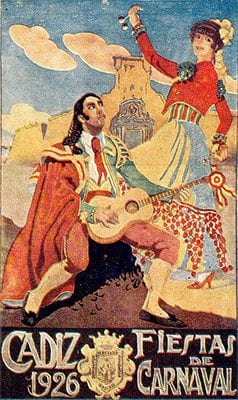The Carnival of Cadiz
The Carnival of Cadiz
The Carnival of Cadiz
-
Hannah
-
Hannah

My latest book, Masquerade, is set in and around Cadiz, one of the eight provinces that constitute the autonomous community of Andalusia. The city of Cadiz, as depicted on the cover of the book, is known as the city of light. It is one of the oldest cities in Europe (founded by Hercules, according to legend) and it makes for a beautiful, lively and colourful backdrop to the story in Masquerade.
As part of my research for each book I write, I visit its setting at least once and immerse myself in the culture. For Masquerade, I could not resist timing my visit to coincide with the annual carnival in the city.
Readers of my novel The Echoes of Love will remember the Venice Carnival, a fabulously flamboyant and atmospheric event for which the city is famous. The Cadiz Carnival is the Spanish equivalent: indeed, it was inspired by the Venice event, way back in the 16th century, when the two port cities became linked through a busy trading route.
The Cadiz Carnival is the carnival to visit in Spain (even Franco never managed to ban the event). It’s such an important and historic event that planning goes on all year for the ten days of festivities, which commence the weekend before Ash Wednesday.
As you would expect at a major carnival, Cadiz has music and dance and costumes and feasting and revelry aplenty. But what really sets it apart is the satirical song contest at its heart, which is so high profile that it is televised nationally. It is held at the Gran TeatroFalla (which features in Masquerade). The following groups of performers compete:
Comparsas: They sing witty and satiric songs about polemic subjects, with serious messages, in groups of around fifteen.
Chirigotas: Like the comparsas, but more light-hearted in their satire. Often largely male and numbering ten in total, they play on carruseles (open carts) outside of the competition.
Coros: Choirs with a mixed humourous and serious repertoire – often accompanied by guitars and lutes.
Cuartetos: They sing with a kazoo and two sticks and have an improvised, theatrical style that raises laughs. Although the name means quartet, the group may number three, four or five.
Romanceros: Soloists. They carry amusing illustrations to accompany their songs.
These groups can be found in the streets during the festival; indeed, you may be minding your own business when a romancero suddenly erupts into full voice beside you! You’ll pick out the group members in a crowd, however, because they wear matching (and very attention-grabbing) outfits. You may also encounter illegales – amateur singing groups that don’t compete in the competition but have a lot of fun singing in the streets accompanied by guitars, drums and whistles.
Not only are the performers unique to the carnival, but so are the musical forms they adhere to in their songs; these have evolved over the history of the carnival:
Presentation: Sung initially to establish the ‘tipo’ (characterisation) of the singing group.
Cuple: A short satirical song relating to the tipo.
Pasodoble: Long song with no chorus that usually has a serious undertone.
Tango: Sung by the choirs.
Potpourri: The singers create new lyrics for well-known songs to convey their message.
Words are very important in all the songs, so much so that the lyric writers can be famous. There is so much intelligence and craft in the songs; they really are memorable. But they are over so fast – no sooner have you understood the nuances of a song than the next is underway.
The Cadiz Carnival, then, is a dazzling, fast-paced spectacle that leaves your head spinning with sights and sounds and sensations. Fabulous inspiration for my writing, and wonderful fun!
